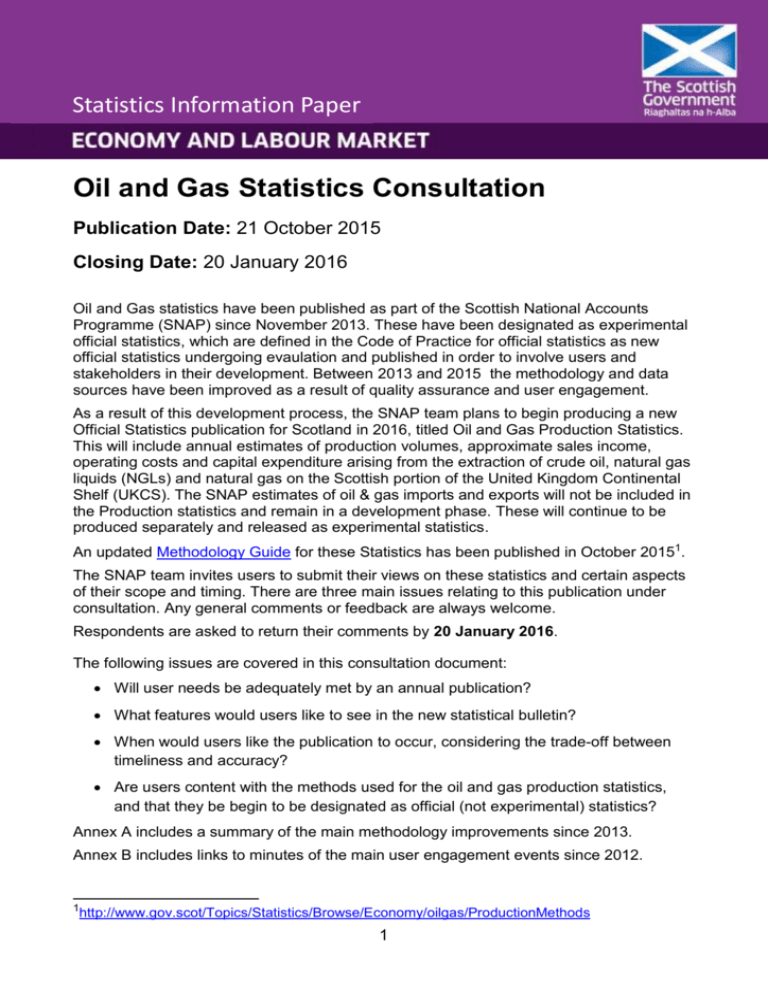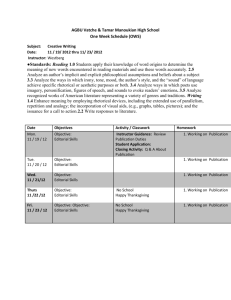Oil and Gas Statistics Consultation
advertisement

Statistics Information Paper Oil and Gas Statistics Consultation Publication Date: 21 October 2015 Closing Date: 20 January 2016 Oil and Gas statistics have been published as part of the Scottish National Accounts Programme (SNAP) since November 2013. These have been designated as experimental official statistics, which are defined in the Code of Practice for official statistics as new official statistics undergoing evaulation and published in order to involve users and stakeholders in their development. Between 2013 and 2015 the methodology and data sources have been improved as a result of quality assurance and user engagement. As a result of this development process, the SNAP team plans to begin producing a new Official Statistics publication for Scotland in 2016, titled Oil and Gas Production Statistics. This will include annual estimates of production volumes, approximate sales income, operating costs and capital expenditure arising from the extraction of crude oil, natural gas liquids (NGLs) and natural gas on the Scottish portion of the United Kingdom Continental Shelf (UKCS). The SNAP estimates of oil & gas imports and exports will not be included in the Production statistics and remain in a development phase. These will continue to be produced separately and released as experimental statistics. An updated Methodology Guide for these Statistics has been published in October 20151. The SNAP team invites users to submit their views on these statistics and certain aspects of their scope and timing. There are three main issues relating to this publication under consultation. Any general comments or feedback are always welcome. Respondents are asked to return their comments by 20 January 2016. The following issues are covered in this consultation document: Will user needs be adequately met by an annual publication? What features would users like to see in the new statistical bulletin? When would users like the publication to occur, considering the trade-off between timeliness and accuracy? Are users content with the methods used for the oil and gas production statistics, and that they be begin to be designated as official (not experimental) statistics? Annex A includes a summary of the main methodology improvements since 2013. Annex B includes links to minutes of the main user engagement events since 2012. 1 http://www.gov.scot/Topics/Statistics/Browse/Economy/oilgas/ProductionMethods 1 Oil and Gas Production Statistics will be published annually, rather than quarterly The main known uses of the experimental quarterly oil and gas statistics appear to be based on annual figures, rather than the results on a quarterly basis or trends to the latest available quarter. However, producing the statistics on a quarterly timetable requires a considerable investment of staff time. The SNAP team propose that staff could be better deployed working on other developments which users have expressed an interest in (for example: other oil and gas statistics (trade, satellite accounts; productivity statistics; or capital investment statistics). Therefore, we propose that the quarterly publication of results will be discontinued and replaced with a new annual publication starting in 2016. This publication will include annual estimates on both calendar year and financial year basis. There will be no quarterly time series in the publication. The main reason for ceasing to publish any quarterly results is that it could be confusing for users when more recent or revised quarterly statistics are published by DECC in between annual releases. Additionally, users have commented that there is insufficient data to provide accurate estimates of within-year trends in operating and capital expenditure. Users can continue to monitor short term movements (monthly or quarterly) using DECC statistics or through announcements in the media relating to oil and gas developments. Given that around 95% of oil extraction and 50% of gas extraction takes place on the Scottish portion of the UKCS, UK headline trends provide a meaningful and timely indicator of Scottish activity. Question 1. Will your needs be adequately met by an annual publication? If not, what alternative approach(es) would you prefer? Question 2. Are there any particular features you would like to see in the Oil and Gas Production Statistics bulletin, for example, any particular tables, charts or areas of commentary and analysis? 2 The timing of the annual publication The Oil and Gas Production figures will continue to be constrained to statistics produced by DECC for the total UKCS, and therefore the timing of the Scottish Government publication depends on when DECC data are available. The main data sources are the annual Digest of UK Energy Statistics (DUKES) publication in late July and the quarterly Energy Trends releases. Please see our Methodology Guide for more information. With all ecconomic statistics there is a trade-off between timeliness and accuracy. The most timely publications do not include all the data available at a later date, meaning that published results can become inconsistent with other sources or be liable to revision in the future. Users are invited to consider the following options for a publication schedule: 1. Late summer 2016: results for 2015 (final) and 2015/16 (provisional) Final calendar-year data for production and receipts by terminal is published in DUKES at the end of July each year. By this date, provisional data for the first quarter of the latest year is available in quarterly Energy Trends published at the end of June. These sources allow a full estimate for the previous calendar year to be produced, along with a provisional estimate for the latest financial year based on the Q1 figure. A publication based on these sources would be released in August or September, depending on resources. 2. Summer 2016: results for 2015 (provisional) and 2015/16 (provisional) Near-final estimates of total production for the latest calendar year are published in the June release of Energy Trends, along with the provisional estimate of Quarter 1. However, the final estimates of production by terminal are not available in Energy Trends. These sources allow a near-final estimate of the previous calendar year to be produced with slightly lower quality than option 1, along with a similar provisional estimate of the latest financial year based on the Q1 figure. A publication based on these sources would be released in July or August, depending on resources. 3. Late Spring 2016: results for 2015 (provisional) and 2014/5 (provisional) Provisional estimates of total production for the latest calendar year are published in the March release of Energy Trends (for Quarter 4). This is the earliest stage at which estimates for the latest year are available, although the quality of this estimate would be slightly lower than option 2, with calendar year results for the UK liable to be revised slightly in June or July by DECC. At this time the most recent financial year estimates available relate to the previous year. A publication based on these sources would be released in April or May, depending on resources. Question 3. Which of the three schedules above would you prefer? Do you have any specific concerns about timeliness or accuracy? 3 Designation as Official Statistics (removal of experimental status) The Scottish Government produce the Oil and Gas Production statistics following the Code of Practice for Official Statistics, and aim to eventually submit them for assessment by the UK Statistics Authority (towards designation as National Statistics) at a future date. To be compliant with the Code, the statistics should: meet user needs, be well explained and readily accessible, be produced according to sound methods, and be managed impartially and objectively in the public interest. Since their initial release in November 2013, the oil and gas production statistics have been subject to ongoing quality assurance and methodology improvement. There has been a significant contribution from users in this process. A summary of the main changes made between 2013 and 2015 is published in Annex A. During this time the statistics have been designated as experimental official statistics. These are defined in the Code of Practice for official statistics as new official statistics undergoing evaulation, and are published in order to involve users and stakeholders in their development and as a means to build in quality at an early stage. The SNAP team proposes that the methods used to produce these statistics have been developed to the point where they are considered sound. Therefore it would no longer be appopriate to refer to the statistics as being experimental (or in development). The new publication is being designed to meet user needs, and will be designed to present the results in an accessible and well explained manner. Question 4. Do you agree that the Oil and Gas Production statistics are now produced according to sound methods and should be designated as official (not experimental) statistics? Yes ☐ No ☐ Do you have any comments about this decision? 4 Further comments If you have any further comments on the methodology, presentation or proposed changes to the statistics, or any other feedback on any SNAP oil and gas statistics, please enter them in the box below. 5 Respondent information Please could you provide your name and contact details. Name/Organization Postal address Email Are you happy for Scottish Government statitsticians to contact you in relation to this consultation exercise? Yes ☐ No ☐ Handling consultation responses The Scottish Government may wish to publish a summary of the responses to the consultation. The contact details of respondents would not be published, and comments will not be attributed to individual resposndents. Would you be happy to be named as a respondent to the consultation? Yes ☐ No ☐ 6 Responding to the consultation Responses to the consultation should be submitted by Wednesday 20th January 2016 You can submit your comments using the options below. By email: Please email your form to: economic.statistics@gov.scot By post: National Accounts Unit Office of the Chief Economic Adviser 4WR St Andrews House Regent Road Edinburgh EH1 3DG 7 Annex A: Summary of methodology changes 2013-2015 An initial methodology document for oil and gas statistics was published in November 2013 2. Since the initial methodology document was published there has been ongoing development and improved quality assurance by the SNAP team, and consultation has taken place with a range of users. Changes to the methodology have been documented within each of the published tables as well as in the updated methodology guide for the statistics. The main changes are detailed below. Production Production estimates previously consisted of total hydrocarbon, liquid and gas estimates. Liquid production figures are now further broken down into crude and NGL production. Production estimates were previously benchmarked only to the annual Digest of UK Energy Statistics (DUKES). Production estimates at the UK level are now also benchmarked to DECC’s quarterly Energy Trends publication, ensuring that each and every quarter is consistent with the UK totals published by DECC.. Sales and costs Quarterly estimates of approximate sales values are now calculated ‘bottom up’ for each product type, rather than ‘top down’ from total hydrocarbons. These ‘bottom up’ estimates also now include the impact of changes to oil and gas prices. In the initial version of the statistics the quarterly sales values were produced using only production trends, which could lead to discontinuities between years where prices had changed markedly. Further details are available in the methodology guide. The liquid split for sales revenues for oil and NGL is now available up to 2008, in line with DECC’s table “Income from and expenditure on UKCS exploration, development and operating activities: annually 1970-2013”. In addition, there is a more accurate sales and revenues liquid split from better matching with commercial data. Following advice from expert users, capital expenditure and ‘other revenues’ (e.g. from tariffs) are now split evenly across all quarters of the year rather than moving in line with production. In the initial releases of these estimates, annual benchmark figures were provided by DECC statistics for previous years, and then estimates in the latest years were benchmarked to forecasts from the OBR and to DECC production projections. This approach led to revisions during periods (such as late-2014) when prices or production were significantly different to the forecasts. In the latest estimates, quarters in the latest year are true short term indicators, benchmarked only to actual outturn in previous years. Additionally, the results from the Oil & Gas UK Activity Survey are used as provisional benchmarks for the latest full year prior to the publication of income and expenditure by DECC. 2 http://www.gov.scot/Topics/Statistics/Browse/Economy/SNAP/expstats/oilandgas/methodology 8 Annex B: Summary of Formal User Engagement 2012-2015 Consultation has taken place with a variety of users during the lifetime of the publication, including ongoing communication with other analysts in the Scottish Government and DECC. This process has helped determine the direction and the development of the statistics. In addition, formal discussion of the statistics has taken place at the following events. Scottish Economic Statistics Consultation Group (SESCG) SESCG was initially consulted on the broad approach to producing oil and gas statiscs at the meeting on 4 October 20123. Methodology and initial results were discussed in more detail on 1 October 2013 4. Oil and Gas Statistics user’s group A SESCG sub-group was formed in 2014, and met for the first time on 4 November 2014 5. Following this, the next release of statistics (for 2014 Q2) included several changes based on suggestions from the group. 3 http://www.gov.scot/Resource/0042/00421507.doc 4 http://www.gov.scot/Topics/Statistics/Browse/Economy/ScotStat/Meetings/SESCG21minutes 5 http://www.gov.scot/Topics/Statistics/Browse/Economy/ScotStat/Meetings/OGS1 9





